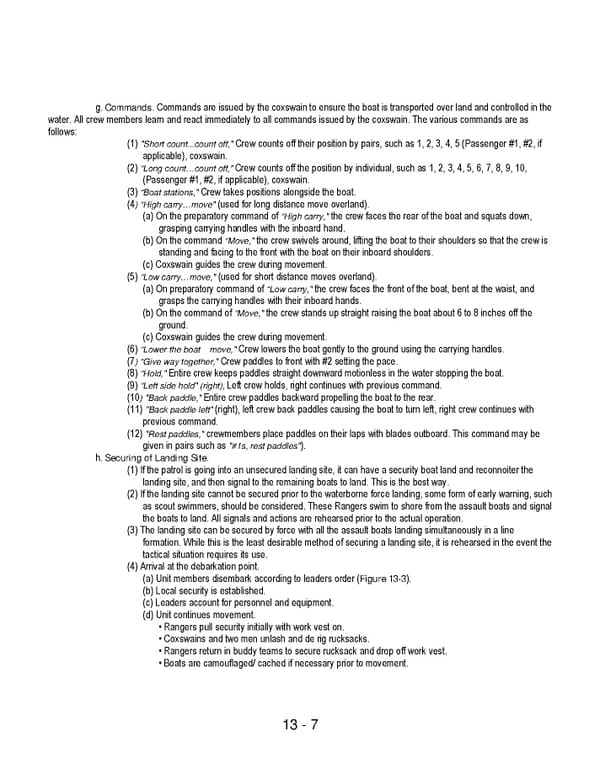13 - 7 g. Commands. Commands are issued by the coxswain to ensure the boat is transported over land and controlled in the water. All crew members learn and react immediately to all commands issued by the coxswain. The various commands are as follows: (1) "Short count...count off," Crew counts off their position by pairs, such as 1, 2, 3, 4, 5 (Passenger #1, #2, if applicable), coxswain. (2) “Long count…count off,” Crew counts off the position by individual, such as 1, 2, 3, 4, 5, 6, 7, 8, 9, 10, (Passenger #1, #2, if applicable), coxswain. (3) “Boat stations," Crew takes positions alongside the boat. (4) “High carry…move" (used for long distance move overland). (a) On the preparatory command of “High carry," the crew faces the rear of the boat and squats down, grasping carrying handles with the inboard hand. (b) On the command “Move," the crew swivels around, lifting the boat to their shoulders so that the crew is standing and facing to the front with the boat on their inboard shoulders. (c) Coxswain guides the crew during movement. (5) “Low carry…move," (used for short distance moves overland). (a) On preparatory command of “Low carry," the crew faces the front of the boat, bent at the waist, and grasps the carrying handles with their inboard hands. (b) On the command of “Move," the crew stands up straight raising the boat about 6 to 8 inches off the ground. (c) Coxswain guides the crew during movement. (6) “Lower the boat move," Crew lowers the boat gently to the ground using the carrying handles. (7) “Give way together," Crew paddles to front with #2 setting the pace. (8) “Hold," Entire crew keeps paddles straight downward motionless in the water stopping the boat. (9) “Left side hold" (right), Left crew holds, right continues with previous command. (10) "Back paddle," Entire crew paddles backward propelling the boat to the rear. (11) ''Back paddle left" (right), left crew back paddles causing the boat to turn left, right crew continues with previous command. (12) "Rest paddles," crewmembers place paddles on their laps with blades outboard. This command may be given in pairs such as "#1s, rest paddles"). h. Securing of Landing Site. (1) If the patrol is going into an unsecured landing site, it can have a security boat land and reconnoiter the landing site, and then signal to the remaining boats to land. This is the best way. (2) If the landing site cannot be secured prior to the waterborne force landing, some form of early warning, such as scout swimmers, should be considered. These Rangers swim to shore from the assault boats and signal the boats to land. All signals and actions are rehearsed prior to the actual operation. (3) The landing site can be secured by force with all the assault boats landing simultaneously in a line formation. While this is the least desirable method of securing a landing site, it is rehearsed in the event the tactical situation requires its use. (4) Arrival at the debarkation point. (a) Unit members disembark according to leaders order (Figure 13-3). (b) Local security is established. (c) Leaders account for personnel and equipment. (d) Unit continues movement. • Rangers pull security initially with work vest on. • Coxswains and two men unlash and de rig rucksacks. • Rangers return in buddy teams to secure rucksack and drop off work vest. • Boats are camouflaged/ cached if necessary prior to movement.
 Ranger Handbook Page 242 Page 244
Ranger Handbook Page 242 Page 244